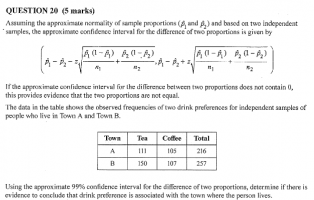ausmathgenius420
New member
- Joined
- Aug 5, 2021
- Messages
- 44
This question comes from a previous exam.

Assuming the normal distribution represents the proportion of people who like tea, I find that the difference of the two proportions is:
[math]\approx(-0.1880,0.0480)[/math]
Thought process:
If I calculated a 99% confidence interval for [imath]\hat{p_{1}}[/imath] and [imath]\hat{p_{2}}[/imath], then subtracted the two, my answer would be as above.
--> there is an 18% difference between the lower confidence value of [imath]\hat{p_{1}}[/imath] and [imath]\hat{p_{2}}[/imath].
--> the lower interval of [imath]\hat{p_{2}}[/imath] is 18% greater than [imath]\hat{p_{1}}[/imath] (since the difference is negative).
Similar inferences can be made for the upper limit (however there is much less difference ~4%).
The exam marking scheme concludes that since 0 is within the confidence interval, there is no evidence that the proportions are different --> drink preference is not related to location.
My thought process (if correct), indicates there is 18% difference between the lower limits of both intervals. How can this just be 'ignored' because 0 is within the interval?
Furthermore, I found the difference in proportions 'with respect' to coffee instead of tea... (-0.0485, 0.1880)... same question stands
Edit: I have that unfortunate sense that the answer is right in front of me ?. To double down on my question though... it is my understanding that if the confidence intervals of [imath]\hat{p_{1}}[/imath] and [imath]\hat{p_{2}}[/imath] were similar (hence little difference), then we would conclude location does not affect the preference of tea - because lots of people like tea in both locations. Conversely, large differences in confidence intervals (18%) would indicate the town one lives in affects their preference of tea/coffee.

Assuming the normal distribution represents the proportion of people who like tea, I find that the difference of the two proportions is:
[math]\approx(-0.1880,0.0480)[/math]
Thought process:
If I calculated a 99% confidence interval for [imath]\hat{p_{1}}[/imath] and [imath]\hat{p_{2}}[/imath], then subtracted the two, my answer would be as above.
--> there is an 18% difference between the lower confidence value of [imath]\hat{p_{1}}[/imath] and [imath]\hat{p_{2}}[/imath].
--> the lower interval of [imath]\hat{p_{2}}[/imath] is 18% greater than [imath]\hat{p_{1}}[/imath] (since the difference is negative).
Similar inferences can be made for the upper limit (however there is much less difference ~4%).
The exam marking scheme concludes that since 0 is within the confidence interval, there is no evidence that the proportions are different --> drink preference is not related to location.
My thought process (if correct), indicates there is 18% difference between the lower limits of both intervals. How can this just be 'ignored' because 0 is within the interval?
Furthermore, I found the difference in proportions 'with respect' to coffee instead of tea... (-0.0485, 0.1880)... same question stands
Edit: I have that unfortunate sense that the answer is right in front of me ?. To double down on my question though... it is my understanding that if the confidence intervals of [imath]\hat{p_{1}}[/imath] and [imath]\hat{p_{2}}[/imath] were similar (hence little difference), then we would conclude location does not affect the preference of tea - because lots of people like tea in both locations. Conversely, large differences in confidence intervals (18%) would indicate the town one lives in affects their preference of tea/coffee.
Last edited:
